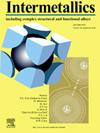A prediction model of failure threshold for shear deformation in a Zr-based bulk metallic glass
IF 4.3
2区 材料科学
Q2 CHEMISTRY, PHYSICAL
引用次数: 0
Abstract
The failure of bulk metallic glasses (BMGs) during plastic deformation at room temperature is abrupt and instantaneous, while the analysis of precursor information based on avalanche events helps predict catastrophic failure. An acoustic emission (AE) signal can provide accurate precursor information for material failure, due to its sensitive and high fast calculation ability. In the current study, AE monitoring tests are carried out during uniaxial compression tests of BMGs at different strain rates. The AE experimental failure threshold, Emax, is proposed on the basis of AE cumulative energy, which reflects the intensity of damage evolution at different loading conditions. Compared with the critical shear band velocity (CSBV) associated with stick-slip dynamics of serrated flow, Emax is a more sensitive failure parameter since it is connected with the local microscopic changes that occur during the material response process. Here, the Emax is obtained prior to reaching the CSBV since the calculation of these two avalanches analysis focuses on the different stages of shear band growth. In particular, AE events are related to the “dry” friction process in the first stage, however, the CSBV is responsible for the “viscous” glide in the second stage. Therefore, Emax is not affected by the complex interactions between the shear bands during the stick-slip process. The maximum avalanche of serrated flow, Smax, is proposed as the experimental failure threshold, which depends on the applied strain rate as . According to the relationship of Emax and Smax, the theoretical failure threshold, Emax, follows a criterion , where λ is equivalent to 0.15 for this work. Combining the different calculations and AE measurements, this model gives new insights to predict the deformation failure behavior of Zr-based BMGs.
求助全文
约1分钟内获得全文
求助全文
来源期刊

Intermetallics
工程技术-材料科学:综合
CiteScore
7.80
自引率
9.10%
发文量
291
审稿时长
37 days
期刊介绍:
This journal is a platform for publishing innovative research and overviews for advancing our understanding of the structure, property, and functionality of complex metallic alloys, including intermetallics, metallic glasses, and high entropy alloys.
The journal reports the science and engineering of metallic materials in the following aspects:
Theories and experiments which address the relationship between property and structure in all length scales.
Physical modeling and numerical simulations which provide a comprehensive understanding of experimental observations.
Stimulated methodologies to characterize the structure and chemistry of materials that correlate the properties.
Technological applications resulting from the understanding of property-structure relationship in materials.
Novel and cutting-edge results warranting rapid communication.
The journal also publishes special issues on selected topics and overviews by invitation only.
 求助内容:
求助内容: 应助结果提醒方式:
应助结果提醒方式:


